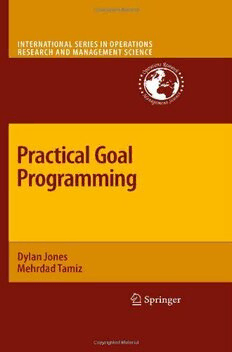Table Of ContentInternational Series in Operations
Research & Management Science
SeriesEditor
FrederickS.Hillier
StanfordUniversity
Forfurthervolumes:
http://www.springer.com/series/6161
·
Dylan Jones Mehrdad Tamiz
Practical Goal Programming
123
DylanJones MehrdadTamiz
LogisticsandManagementMathematics CollegeofBusinessAdministration
Group DepartmentofQuantitativeMethods
DepartmentofMathematics andInformationSystems
UniversityofPortsmouth KuwaitUniversity
LionGateBuilding P.O.Box5486
LionTerrace Safat13055
Portsmouth Kuwait
UKPO13HF [email protected]
[email protected]
ISSN0884-8289
ISBN978-1-4419-5770-2 e-ISBN978-1-4419-5771-9
DOI10.1007/978-1-4419-5771-9
SpringerNewYorkDordrechtHeidelbergLondon
LibraryofCongressControlNumber:2010921491
©SpringerScience+BusinessMedia,LLC2010
Allrightsreserved.Thisworkmaynotbetranslatedorcopiedinwholeorinpartwithoutthewritten
permission of the publisher (Springer Science+Business Media, LLC, 233 Spring Street, New York,
NY10013,USA),exceptforbriefexcerptsinconnectionwithreviewsorscholarlyanalysis.Usein
connectionwithanyformofinformationstorageandretrieval,electronicadaptation,computersoftware,
orbysimilarordissimilarmethodologynowknownorhereafterdevelopedisforbidden.
Theuseinthispublicationoftradenames,trademarks,servicemarks,andsimilarterms,eveniftheyare
notidentifiedassuch,isnottobetakenasanexpressionofopinionastowhetherornottheyaresubject
toproprietaryrights.
Printedonacid-freepaper
SpringerispartofSpringerScience+BusinessMedia(www.springer.com)
Dedicatedtoourparents
RahmatTamizandMahtalatHelmi
and
JamesJonesandBrendaJones
Preface
The setting and attainment of goals is a fundamental aspect of human decision
making, which is manifest in the modern discipline of operational research by the
technique of goal programming. Influences from the fields of mathematical pro-
gramming and multiple criteria decision making (MCDM) can be found in goal
programming, and it is our view that in order to use goal programming most
effectively,usersshouldbeawareofthebasicaspectsandconceptsofbothfields.
Weareawarethatthiswillnotbethefirstbookongoalprogrammingandhave
ourselves learnt about the topic from the previous works of Charnes and Cooper
(1961),Lee(1970),Ignizio(1976,1982,1985,1994),andRomero(1991).Wehave
noted,however,thatmostoftheseexcellentbooksarenowoutofprint,andpracti-
tionersandpost-graduatestudentsinthefieldarereportingincreasingdifficultyin
obtaining a work that will allow them to grasp the fundamentals of goal program-
mingandhenceutilisethefullpowerandflexibilityofthetechnique.Itisalsoour
desiretoseegoalprogrammingcontinuetodevelopandbeappliedinapracticaland
correctmanner.Wewouldalsolikeusersofthetechniquetohaveaccesstoandthe
abilitytochoosefromthefullrangeofvariantsandextensionsofgoalprogramming
and its analysis tools in order to build models that best reflect the preferences and
desiresoftheirdecisionmaker(s).
The purpose of this book is therefore to empower academics and practitioners
to be able to build effective goal programming models, as well as to detail the
current state of the art in the topic and lay the foundation for its future devel-
opment and continued application to new and varied fields of application as they
arise.
ThenotationandterminologyusedinthisbookforinvestigatingGPanditsvari-
antshavebeendesignedandrefinedincollaborationwiththeleadingexpertsinthe
field.Webelievetheygivethebestdescriptionofthesubjectandwouldwantthem
tobecomethestandards.
This book is divided into nine chapters. Chapter 1 gives a brief history of goal
programming and details the fundamental definitions arising from the fields of
mathematical programming and multiple criteria decision making that are used
throughoutthetext.Asectionontheunderlyingphilosophiesofgoalprogramming
isalsoincluded.Chapter2detailsthegoalprogrammingvariantsanddefinesthem
algebraically.
vii
viii Preface
Chapter 3 is particularly important to readers unfamiliar with goal program-
mingwhowishtolearnhowtobuildeffectivegoalprogrammingmodelsthatavoid
common modelling pitfalls and formulation errors. It details the step-by-step for-
mulationofabasicgoalprogrammingmodelintheformofeachofthethreemain
variants, as well as discussing basic modelling techniques. Chapter 4 details more
advanced modelling issues and highlights some recently proposed extensions as
wellasgivinganewandpragmaticweightsensitivityalgorithm.
Chapter5detailsthesolutionmethodologiesofgoalprogramming,concentrating
on computerised solution by the Excel Solver and LINGO packages for each of
the three main variants. A discussion of the viability and use of specialised goal
programmingpackagesisalsoincluded.Chapter6discussesthelinkagesbetween
Pareto efficiency and goal programming. The state of the art in detecting Pareto
inefficiencyandrestoringParetoefficiencyforeachofthemajorvariantsisgiven.
Chapters3–6aresupportedbyasetof10exercisesdrawnfromourtwodecades
of experience of applying goal programming to practical decision-making situa-
tions.AnExcelspreadsheetgivingthebasicsolutionofeachexamplecanbefound
ontheaccompanyingwebsite(www.mopgp.com).
Chapter 7 details the current state of the art in terms of the integration of goal
programming with other techniques from operational research and artificial intel-
ligence. This is a key area which we believe will be an important topic of future
research.
The text concludes with two case studies which are chosen to demonstrate the
application of goal programming in practice and to illustrate the principles devel-
opedinChapters1–7.Chapter8detailsanapplicationinhealthcareandChapter9
describesapplicationsinportfolioselection.
We are indebted to the many researchers in the field whose works on goal pro-
gramming,conversations,andpresentationsonthetopichavehelpedshapethistext.
InparticularwewouldliketoacknowledgetheseminalworkofJamesIgnizioand
Carlos Romero. We would also like to thank the many academic members, inter-
national visitors, and doctoral students of the Management Mathematics Group at
the University of Portsmouth, who have contributed to our research on the the-
ory and application of goal programming in the past two decades. These include
Simon Mardle, Rishma Hasham, Keith Fargher, Bijan Hesni, Keyvan Mir-Razavi,
Sita Patel, Zul Mohd-Nopiah, Richard Treloar, John-Paul Oddoye, Jon Large,
PatrickBeullens,RezaKhorramshahgol,XiaoDongLi,KevinWillis,RaniaAzmi,
BlancaPerez,AmeliaBilbao,AliForoughi,MohammadAliYaghoobi,Mohammad
Afzalinejad, and Ersilia Liguigli. We are also grateful to Dr Paul Schmidt of the
QueenAlexandraHospitalinPortsmouthforhishelpindevelopingthecasestudy
described in Chapter 8. We would also like to thank the British Royal Society for
providing Dr Jones with an international visiting fellowship to the University of
Malaga,Spain,wherewritingofthisbookwasstarted.DrJoneswouldalsoliketo
thankRafaelCaballeroandthemembersoftheDepartmentofAppliedEconomics
at the University of Malaga; Maria-Victoria Rodriguez and the members of the
Department of Quantitative Economics at the University of Oviedo; and Sydney
ChuandthemembersoftheDepartmentofMathematics,UniversityofHongKong,
Preface ix
fortheirhospitalityandusefuldiscussionsaboutgoalprogrammingduringhisstay
attheirrespectiveinstitutions.
Last,butnotleast,weinitiatedtheinternationalseriesofbi-annualconferencesin
multi-objectiveandgoalprogramming(MOPGP).Theseventhconferencewasheld
inPortsmouthinSeptember2008.WewouldparticularlyliketothankBelaidAouni
andRalphSteuerfortheiron-goingcommitmentandhelpinensuringthesuccessof
thisconferenceseriesovertheyears.Wealsowishtothankallthedelegatesofthese
conferencesfortheirparticipation,usefuldiscussions,andindirectcontributionsto
thecompletionofthisbook.
Finally, we would like to thank our families: Sherry, Yasaman, and Sam
Rahmat Tamiz; and Katia, Thais, Isabella, and Owen Jones for their support and
encouragementduringthesometimestime-consumingprocessofwritingthisbook.
UniversityofPortsmouth,UK DylanJones
KuwaitUniversity,Kuwait MehrdadTamiz
September2009

